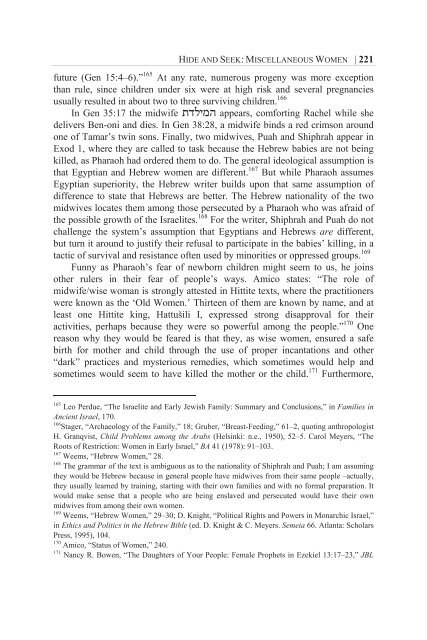Women at Work in the Deuteronomistic History - International Voices ...
Women at Work in the Deuteronomistic History - International Voices ...
Women at Work in the Deuteronomistic History - International Voices ...
You also want an ePaper? Increase the reach of your titles
YUMPU automatically turns print PDFs into web optimized ePapers that Google loves.
HIDE AND SEEK: MISCELLANEOUS WOMEN | 221<br />
future (Gen 15:4–6).” 165 At any r<strong>at</strong>e, numerous progeny was more exception<br />
than rule, s<strong>in</strong>ce children under six were <strong>at</strong> high risk and several pregnancies<br />
usually resulted <strong>in</strong> about two to three surviv<strong>in</strong>g children. 166<br />
In Gen 35:17 <strong>the</strong> midwife תדלימ ה appears, comfort<strong>in</strong>g Rachel while she<br />
delivers Ben-oni and dies. In Gen 38:28, a midwife b<strong>in</strong>ds a red crimson around<br />
one of Tamar’s tw<strong>in</strong> sons. F<strong>in</strong>ally, two midwives, Puah and Shiphrah appear <strong>in</strong><br />
Exod 1, where <strong>the</strong>y are called to task because <strong>the</strong> Hebrew babies are not be<strong>in</strong>g<br />
killed, as Pharaoh had ordered <strong>the</strong>m to do. The general ideological assumption is<br />
th<strong>at</strong> Egyptian and Hebrew women are different. 167 But while Pharaoh assumes<br />
Egyptian superiority, <strong>the</strong> Hebrew writer builds upon th<strong>at</strong> same assumption of<br />
difference to st<strong>at</strong>e th<strong>at</strong> Hebrews are better. The Hebrew n<strong>at</strong>ionality of <strong>the</strong> two<br />
midwives loc<strong>at</strong>es <strong>the</strong>m among those persecuted by a Pharaoh who was afraid of<br />
<strong>the</strong> possible growth of <strong>the</strong> Israelites. 168 For <strong>the</strong> writer, Shiphrah and Puah do not<br />
challenge <strong>the</strong> system’s assumption th<strong>at</strong> Egyptians and Hebrews are different,<br />
but turn it around to justify <strong>the</strong>ir refusal to particip<strong>at</strong>e <strong>in</strong> <strong>the</strong> babies’ kill<strong>in</strong>g, <strong>in</strong> a<br />
tactic of survival and resistance often used by m<strong>in</strong>orities or oppressed groups. 169<br />
Funny as Pharaoh’s fear of newborn children might seem to us, he jo<strong>in</strong>s<br />
o<strong>the</strong>r rulers <strong>in</strong> <strong>the</strong>ir fear of people’s ways. Amico st<strong>at</strong>es: “The role of<br />
midwife/wise woman is strongly <strong>at</strong>tested <strong>in</strong> Hittite texts, where <strong>the</strong> practitioners<br />
were known as <strong>the</strong> ‘Old <strong>Women</strong>.’ Thirteen of <strong>the</strong>m are known by name, and <strong>at</strong><br />
least one Hittite k<strong>in</strong>g, H<strong>at</strong>tušili I, expressed strong disapproval for <strong>the</strong>ir<br />
activities, perhaps because <strong>the</strong>y were so powerful among <strong>the</strong> people.” 170 One<br />
reason why <strong>the</strong>y would be feared is th<strong>at</strong> <strong>the</strong>y, as wise women, ensured a safe<br />
birth for mo<strong>the</strong>r and child through <strong>the</strong> use of proper <strong>in</strong>cant<strong>at</strong>ions and o<strong>the</strong>r<br />
“dark” practices and mysterious remedies, which sometimes would help and<br />
sometimes would seem to have killed <strong>the</strong> mo<strong>the</strong>r or <strong>the</strong> child. 171 Fur<strong>the</strong>rmore,<br />
165<br />
Leo Perdue, “The Israelite and Early Jewish Family: Summary and Conclusions,” <strong>in</strong> Families <strong>in</strong><br />
Ancient Israel, 170.<br />
166<br />
Stager, “Archaeology of <strong>the</strong> Family,” 18; Gruber, “Breast-Feed<strong>in</strong>g,” 61–2, quot<strong>in</strong>g anthropologist<br />
H. Granqvist, Child Problems among <strong>the</strong> Arabs (Hels<strong>in</strong>ki: n.e., 1950), 52–5. Carol Meyers, “The<br />
Roots of Restriction: <strong>Women</strong> <strong>in</strong> Early Israel,” BA 41 (1978): 91–103.<br />
167<br />
Weems, “Hebrew <strong>Women</strong>,” 28.<br />
168<br />
The grammar of <strong>the</strong> text is ambiguous as to <strong>the</strong> n<strong>at</strong>ionality of Shiphrah and Puah; I am assum<strong>in</strong>g<br />
<strong>the</strong>y would be Hebrew because <strong>in</strong> general people have midwives from <strong>the</strong>ir same people –actually,<br />
<strong>the</strong>y usually learned by tra<strong>in</strong><strong>in</strong>g, start<strong>in</strong>g with <strong>the</strong>ir own families and with no formal prepar<strong>at</strong>ion. It<br />
would make sense th<strong>at</strong> a people who are be<strong>in</strong>g enslaved and persecuted would have <strong>the</strong>ir own<br />
midwives from among <strong>the</strong>ir own women.<br />
169<br />
Weems, “Hebrew <strong>Women</strong>,” 29–30; D. Knight, “Political Rights and Powers <strong>in</strong> Monarchic Israel,”<br />
<strong>in</strong> Ethics and Politics <strong>in</strong> <strong>the</strong> Hebrew Bible (ed. D. Knight & C. Meyers. Semeia 66. Atlanta: Scholars<br />
Press, 1995), 104.<br />
170<br />
Amico, “St<strong>at</strong>us of <strong>Women</strong>,” 240.<br />
171<br />
Nancy R. Bowen, “The Daughters of Your People: Female Prophets <strong>in</strong> Ezekiel 13:17–23,” JBL




